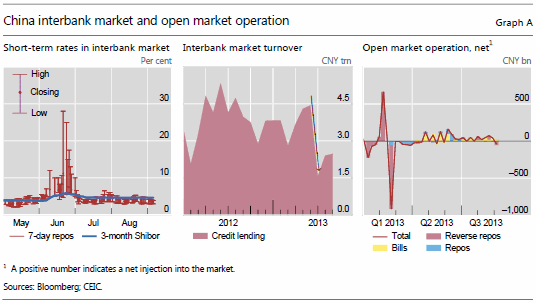Interbank volatility in China
(Extract from pages 10-11 of BIS Quarterly Review, September 2013)
China's interbank market experienced a severe liquidity squeeze in June. The liquidity shortage started in May, with the benchmark overnight and seven-day repo rates gradually moving up towards 5% after staying in the 2-3% range in the first few months of this year (Graph A, left-hand panel). These rates then rose to above 10% in mid-June, soaring to record highs of 25% and 30% on 20 June before settling back into a still high range of 5-8% on 25 June 2013. Meanwhile, the Shanghai interbank offered rate (Shibor) spiked as well. The liquidity squeeze also led to large intraday rate movements. The biggest high-low daily range for the seven-day repo rate was 2,329 basis points on 20 June, compared with an average of 154 basis points in the first five months of 2013.
Interbank activity contracted significantly as a result. Interbank loans fell by over 60% from May to June to CNY 1.6 trillion (Graph A, centre panel). In July and August, the interbank lending volume rebounded to around CNY 2.4 trillion, but was still well below the monthly average of CNY 3.8 trillion in the first five months of this year, and the average of CNY 3.9 trillion for 2012.
Both supply and demand factors are likely to have contributed to the tighter funding conditions in the interbank market. On the supply side, a marked slowdown in US dollar inflows began in late May, entailing much less foreign exchange intervention and renminbi conversion. This was attributable to both domestic and global factors, including narrower trade surpluses (partly due to crackdowns on export over-invoicing), tightened rules on onshore US dollar lending, more bearish market sentiment about China's growth prospects, and a rise in global risk aversion upon intensified speculation over the United States' tapering of asset purchases. On the demand side, increased reserve requirements for banks from tighter rules on "wealth management products" and greater funding needs owing to reduced rollovers in these products compounded seasonal demand for liquidity, adding to market stress. The People's Bank of China (PBoC) did not initially meet surging demand in the interbank market, effectively allowing tighter funding conditions. This was interpreted by some market participants as reflecting the PBoC's intent to rein in the growth of lending to the shadow banking sector. There was even some speculation in the market that the PBoC was signalling monetary tightening. All these interpretations contributed to a more cautious lending stance by banks and the resultant liquidity squeeze.
The market calmed when the PBoC subsequently provided more liquidity and forcefully communicated its determination to stabilise markets. On 24 June, the central bank communicated its assessment that the overall liquidity condition was adequate, but acknowledged the challenges banks faced in managing liquidity at this juncture.
On 25 June, the PBoC stated its intention to "actively make use of open market operations, re-financing, short-term liquidity operations and [the] standing facility, to regulate interbank liquidity, limit unusual volatility, stabilise market expectations, and maintain money market stability". While liquidity provision through open market operations did not increase significantly (Graph A, right-hand panel), the central bank bilaterally provided liquidity to financial institutions that met macroprudential criteria but needed short-term liquidity support. Major commercial banks and policy banks with surplus liquidity were also encouraged to lend into the interbank market.



